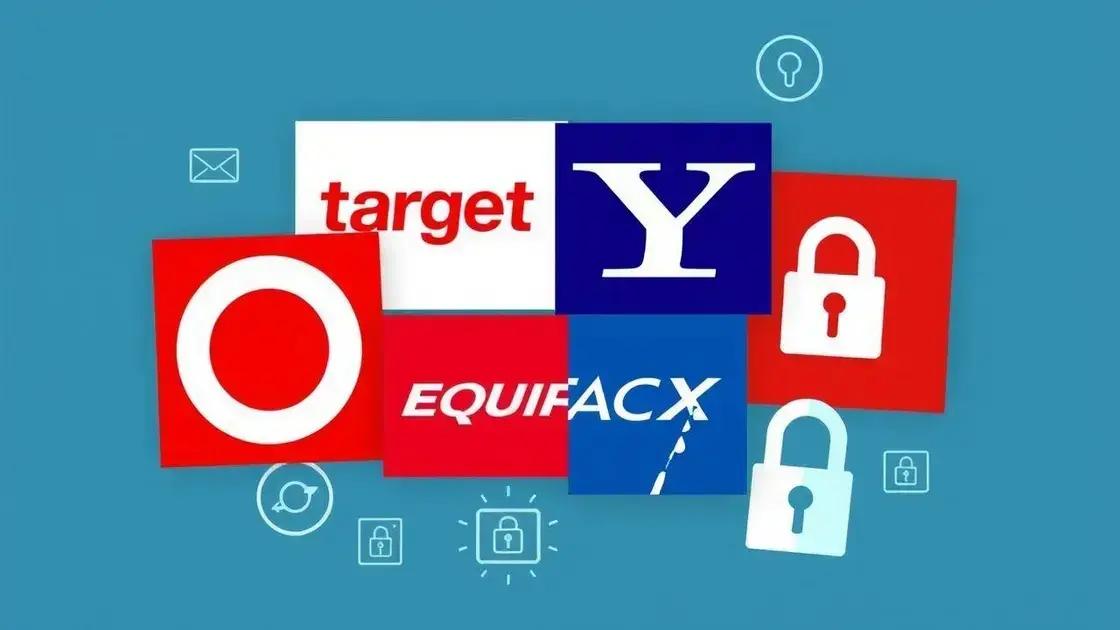Data breaches in government systems: what you need to know

Data breaches in government systems occur when unauthorized access compromises sensitive information, significantly impacting public trust and necessitating robust preventative measures like security audits and employee training.
Data breaches in government systems are becoming increasingly common, raising concerns about security and privacy. Have you ever wondered how these incidents could affect your community? Let’s dive into the details.
Types of data breaches affecting government entities
Understanding the types of data breaches affecting government entities is crucial for protecting sensitive information. Various forms of breaches can occur, each with their own implications and methods of prevention. In this section, we will explore some of the most common types of breaches.
Unauthorized Access
Unauthorized access occurs when individuals gain access to information they aren’t permitted to see. This can happen through stolen credentials or exploiting system vulnerabilities. Effective security measures are essential to prevent these incidents.
Malware Attacks
Malware attacks are designed to infiltrate and damage computer systems. These attacks can lead to data theft or destruction of vital information. Governments must implement strong antivirus software and conduct regular security audits to mitigate risks.
Phishing Scams
Phishing scams manipulate individuals into providing sensitive information through deceptive messages. These tactics often target government employees who process confidential data. Awareness training is key in stopping these attacks.
- Training employees to recognize phishing attempts
- Using multi-factor authentication
- Regularly updating security protocols and software
Another common type of breach is when data is inadvertently exposed due to misconfigurations in cloud storage or databases. These exposed records can be accessed by unauthorized parties, leading to significant risks for government entities.
Ransomware Attacks
Ransomware attacks hold data hostage by encrypting it and demanding payment for decryption. Government systems often store critical data, which makes them prime targets. Implementing robust backup systems is vital for recovery.
Insider Threats
Insider threats pose another significant risk as employees may intentionally or unintentionally leak sensitive information. Conducting thorough background checks and promoting a strong security culture can greatly reduce these threats.
By understanding these different types of data breaches, government entities can take proactive steps to safeguard their information systems. Recognizing vulnerabilities and implementing effective security measures is essential for protecting against potential threats.
Impact of data breaches on public trust

The impact of data breaches on public trust is significant and can last for years. When a government entity experiences a breach, it raises questions about security measures and the ability to protect sensitive information. The public’s confidence can quickly diminish, leading to skepticism regarding government operations.
Transparency and Accountability
Transparency is crucial for rebuilding trust after a breach. When government agencies communicate openly about the breach, its causes, and the steps taken to mitigate damage, they can help restore public confidence. Accountability measures, such as reviewing security policies and implementing new protocols, also play a key role.
Impact on Public Perception
A data breach often changes how citizens perceive their government. Many may feel vulnerable and concerned about the security of their personal information. This feeling of vulnerability can lead to decreased engagement with government services and a reluctance to share necessary information.
- Citizens may withdraw from participating in programs that require data sharing.
- Public scrutiny of government agencies can increase, putting additional pressure on officials.
- Trust can take a long time to rebuild, affecting the agency’s reputation.
Further, the ramifications don’t stop at public perception. There can also be financial implications stemming from data breaches. Increased costs associated with providing identity protection services or implementing new security measures can strain government budgets. These challenges often lead to discussions on whether funds could be better allocated to essential services rather than addressing the fallout from breaches.
Additionally, persistent breaches may lead to legislation changes focusing on data protection laws. When citizens demand more stringent security measures, lawmakers may respond by introducing new regulations aimed at enhancing data security protocols.
Preventative measures for government systems
Implementing preventative measures for government systems is essential to guard against data breaches. By taking proactive steps, agencies can reduce vulnerabilities and enhance the security of sensitive information. This section outlines effective strategies for strengthening security measures.
Regular Security Audits
Conducting regular security audits allows organizations to identify weaknesses in their systems. These evaluations should include network security, software vulnerabilities, and user compliance. Regular audits help ensure that any identified risks are addressed promptly.
Employee Training and Awareness
Training employees is critical in the prevention of data breaches. Staff should be trained on how to recognize potential threats, such as phishing attacks, and the importance of maintaining strong passwords. Regular training sessions can keep security awareness fresh in their minds.
- Use examples of past breaches to illustrate risks.
- Include role-playing scenarios to enhance learning.
- Provide clear guidelines for reporting suspicious activities.
Additionally, implementing strong password policies can significantly reduce the risk of unauthorized access. Government systems should enforce guidelines for creating complex passwords and change them regularly. Utilizing multi-factor authentication (MFA) adds an extra layer of protection, making it more difficult for hackers to breach accounts.
Data Encryption
Data encryption is another vital measure to secure sensitive information. By encrypting data both at rest and in transit, organizations can protect it from unauthorized access. Encryption ensures that even if data is intercepted, it remains unreadable without the proper decryption keys.
Up-to-Date Software and Security Patches
Keeping software up to date is crucial for defending against known vulnerabilities. Government systems should consistently apply security patches and updates as they become available. This practice helps close security gaps that cybercriminals could exploit.
Creating a culture of security within government entities can also contribute to effectively preventing data breaches. Encourage open communication about potential threats and successes in mitigating risks. By fostering a proactive security environment, agencies can better protect themselves from imminent threats.
Case studies of significant breaches in history

Examining case studies of significant breaches in history provides valuable insights into how data breaches occur and the impact they can have. Analyzing these events helps organizations better understand vulnerabilities and implement safeguards to prevent similar incidents.
Target Corporation Data Breach (2013)
In 2013, the Target Corporation experienced a massive data breach that affected millions of customers. Hackers gained access to credit and debit card information through compromised vendor credentials. This breach highlighted the importance of securing third-party access and improving vendor security protocols.
Equifax Data Breach (2017)
The Equifax breach of 2017 was one of the largest and most damaging in history. Cybercriminals exploited a vulnerability in the software of this credit reporting agency, compromising sensitive data belonging to approximately 147 million people. Following this incident, many discussions arose regarding the need for stricter regulations on data protection.
- Impact on individuals’ financial security.
- Equifax faced significant lawsuits and penalties.
- Consumer trust in credit reporting agencies was severely affected.
Another notable breach occurred in 2017 with the hacking of the Democratic National Committee (DNC) email system. This incident not only exposed sensitive political communications but also raised serious concerns about election security and the integrity of democratic processes. It underscored the need for governments and organizations to bolster their cybersecurity defenses.
Yahoo Data Breaches (2013-2014)
In a series of breaches between 2013 and 2014, Yahoo revealed that over 3 billion accounts were affected, making it one of the largest breaches to date. These incidents demonstrated the importance of timely communication with users regarding potential risks and the necessity of implementing robust protective measures.
These case studies remind us of the lasting effect data breaches can have on organizations, individuals, and public trust. They underscore the need for ongoing vigilance and improvement in cybersecurity practices.
FAQ – Frequently Asked Questions about Data Breaches in Government Systems
What are data breaches and how do they happen?
Data breaches occur when unauthorized individuals gain access to sensitive information. They can happen through hacking, phishing scams, or even insider threats.
Why is public trust important after a data breach?
Public trust is crucial because it affects how citizens perceive government agencies. A breach can lead to skepticism about data security and impact citizens’ willingness to share information.
What preventative measures can government agencies take?
Agencies can implement regular security audits, conduct employee training, use strong password policies, and encrypt data to prevent breaches.
What are some notable case studies of data breaches?
Significant breaches include the Target data breach in 2013 and the Equifax breach in 2017. These incidents illustrate the severe impact of data breaches on organizations and individuals.





